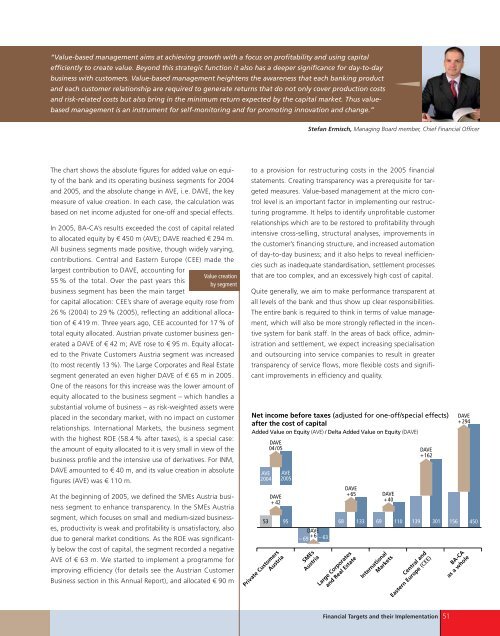team spirit - Bankier.pl
team spirit - Bankier.pl
team spirit - Bankier.pl
You also want an ePaper? Increase the reach of your titles
YUMPU automatically turns print PDFs into web optimized ePapers that Google loves.
“Value-based management aims at achieving growth with a focus on profitability and using capital<br />
efficiently to create value. Beyond this strategic function it also has a deeper significance for day-to-day<br />
business with customers. Value-based management heightens the awareness that each banking product<br />
and each customer relationship are required to generate returns that do not only cover production costs<br />
and risk-related costs but also bring in the minimum return expected by the capital market. Thus valuebased<br />
management is an instrument for self-monitoring and for promoting innovation and change.”<br />
The chart shows the absolute figures for added value on equity<br />
of the bank and its operating business segments for 2004<br />
and 2005, and the absolute change in AVE, i.e. DAVE, the key<br />
measure of value creation. In each case, the calculation was<br />
based on net income adjusted for one-off and special effects.<br />
In 2005, BA-CA’s results exceeded the cost of capital related<br />
to allocated equity by € 450 m (AVE); DAVE reached € 294 m.<br />
All business segments made positive, though widely varying,<br />
contributions. Central and Eastern Europe (CEE) made the<br />
largest contribution to DAVE, accounting for<br />
Value creation<br />
55 % of the total. Over the past years this<br />
by segment<br />
business segment has been the main target<br />
for capital allocation: CEE’s share of average equity rose from<br />
26 % (2004) to 29 % (2005), reflecting an additional allocation<br />
of € 419 m. Three years ago, CEE accounted for 17 % of<br />
total equity allocated. Austrian private customer business generated<br />
a DAVE of € 42 m; AVE rose to € 95 m. Equity allocated<br />
to the Private Customers Austria segment was increased<br />
(to most recently 13 %). The Large Corporates and Real Estate<br />
segment generated an even higher DAVE of € 65 m in 2005.<br />
One of the reasons for this increase was the lower amount of<br />
equity allocated to the business segment – which handles a<br />
substantial volume of business – as risk-weighted assets were<br />
<strong>pl</strong>aced in the secondary market, with no impact on customer<br />
relationships. International Markets, the business segment<br />
with the highest ROE (58.4 % after taxes), is a special case:<br />
the amount of equity allocated to it is very small in view of the<br />
business profile and the intensive use of derivatives. For INM,<br />
DAVE amounted to € 40 m, and its value creation in absolute<br />
figures (AVE) was € 110 m.<br />
At the beginning of 2005, we defined the SMEs Austria business<br />
segment to enhance transparency. In the SMEs Austria<br />
segment, which focuses on small and medium-sized businesses,<br />
productivity is weak and profitability is unsatisfactory, also<br />
due to general market conditions. As the ROE was significantly<br />
below the cost of capital, the segment recorded a negative<br />
AVE of € 63 m. We started to im<strong>pl</strong>ement a programme for<br />
improving efficiency (for details see the Austrian Customer<br />
Business section in this Annual Report), and allocated € 90 m<br />
Stefan Ermisch, Managing Board member, Chief Financial Officer<br />
to a provision for restructuring costs in the 2005 financial<br />
statements. Creating transparency was a prerequisite for targeted<br />
measures. Value-based management at the micro control<br />
level is an important factor in im<strong>pl</strong>ementing our restructuring<br />
programme. It helps to identify unprofitable customer<br />
relationships which are to be restored to profitability through<br />
intensive cross-selling, structural analyses, improvements in<br />
the customer’s financing structure, and increased automation<br />
of day-to-day business; and it also helps to reveal inefficiencies<br />
such as inadequate standardisation, settlement processes<br />
that are too com<strong>pl</strong>ex, and an excessively high cost of capital.<br />
Quite generally, we aim to make performance transparent at<br />
all levels of the bank and thus show up clear responsibilities.<br />
The entire bank is required to think in terms of value management,<br />
which will also be more strongly reflected in the incentive<br />
system for bank staff. In the areas of back office, administration<br />
and settlement, we expect increasing specialisation<br />
and outsourcing into service companies to result in greater<br />
transparency of service flows, more flexible costs and significant<br />
improvements in efficiency and quality.<br />
Net income before taxes (adjusted for one-off/special effects)<br />
after the cost of capital<br />
Added Value on Equity (AVE) / Delta Added Value on Equity (DAVE)<br />
AVE<br />
2004<br />
53<br />
DAVE<br />
04/05<br />
DAVE<br />
+42<br />
AVE<br />
2005<br />
95<br />
Private Customers<br />
Austria<br />
DAVE<br />
+6<br />
–69 –63<br />
SMEs<br />
Austria<br />
68 133 69 110 139 301 156<br />
Large Corporates<br />
and Real Estate<br />
DAVE<br />
+65 DAVE<br />
+40<br />
International<br />
Markets<br />
DAVE<br />
+162<br />
Central and<br />
Eastern Europe (CEE)<br />
Financial Targets and their Im<strong>pl</strong>ementation 51<br />
DAVE<br />
+ 294<br />
BA-CA<br />
as a whole<br />
450
















